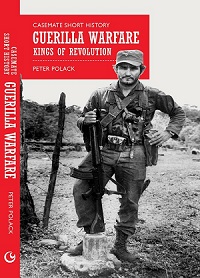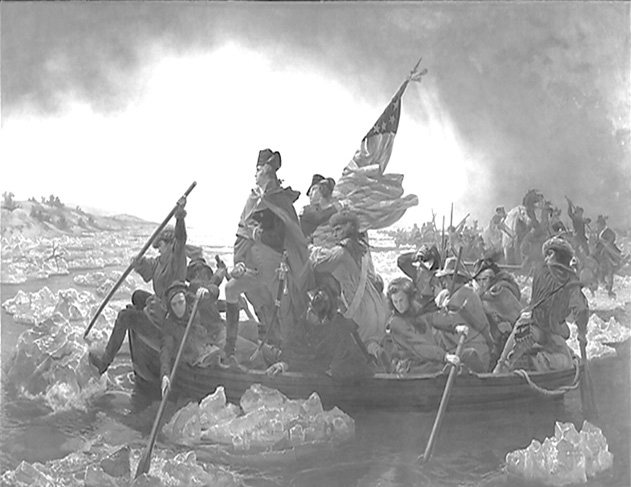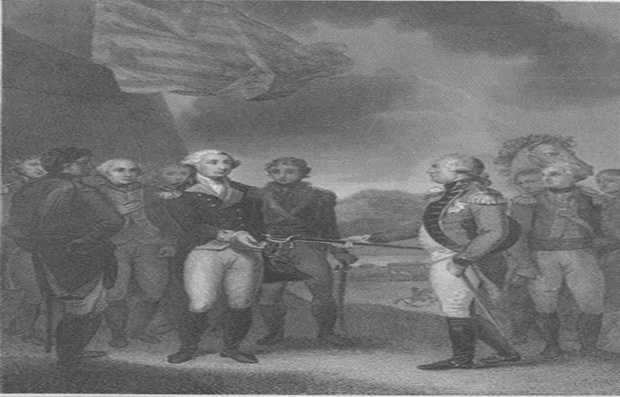Guerrilla Warfare: Kings of Revolution – Book Excerpt - Chapter 2: George Washington
Peter Polack

Guerrilla Warfare: Kings of Revolution by Peter Polack - Casemate Short History Series

Washington Crossing the Delaware – Metropolitan Mueseum of Art
Until his unconventional victory at Trenton in December 1776, the military leader of the now United States of America had incurred a series of losses both on the battlefield and of political confidence in his leadership, most just after the declaration of independence on 4 July 1776.
Shortly thereafter, the first and largest battle of the war against the British took place in August in Brooklyn, New York, also called the Battle of Long Island that saw the Revolutionary Army bested by a professional force led by experienced and determined officers. The British army had several centuries of development proven in many wars and was a formidable force in which overconfidence naturally prevailed in the war of the American Revolution.[i]
Trenton was a real guerrilla action in which a military leader, classically trained, sought to strike against a fixed military position, which in its genre, would have resulted in retreat if faced with firm opposition or capture of the target. George Washington chose a plan to be implemented in a manner and at a time not seen before in the revolutionary conflict of the USA which was destined to catch the opposing elite force of German mercenaries by surprise and eventually, complete defeat of the Hessians. The plan was simple in concept. The movement of several thousand soldiers to face an encamped enemy half their number, at night, on the well-known public holiday of Christmas Day, accompanied by three times the artillery compliment of the target, in the dead of winter, going across a swift, wide, ice ridden river.
Washington had his force of over two thousand men and eighteen pieces of artillery mustered at dusk to begin a Christmas night crossing of the Delaware River from Pennsylvania into British held New Jersey across a flowing waterway beset with large floes of ice that could crush or sink a boat. Among the many vessels utilized for the event were long, short draft Durham boats capable of carrying many tons of cargo crewed by Massachusetts sailors from Marblehead.
Various delays including worsening weather saw the force across but nine miles north of Trenton in the early morning. Washington nevertheless pursued the attack and divided his force into east and west elements for an encompassing attack on the slothful but still dangerous Hessians.[ii]
The Trenton attack force had a key commander in Colonel Henry Knox who secured the crossing of men and cannon before proceeding to Trenton where artillery was strategically placed and moved, when necessary, to command the open streets. Hessians were neither unable to form up for a significant counter-attack or reduce themselves to small roving irregular bands under the Germanic military theory prevailing at that time.
In general terms, heavy and slow artillery have not been part of the guerrilla arsenal but used and discarded after capture as part of an overall strategy or retained if desired for the rare occasions of securing base territory gathering points. Over time, artillery has seen replacement by the ubiquitous rocket propelled grenades, wire guided anti-tank mobile missiles or shoulder fired anti- aircraft missiles and more recently vehicle borne explosive devices.[iii]
On 26 December 1776, Washington led his men to the first encounter with a Hessian outpost, a mile from Trenton, when there was an exchange of gunfire before they fled to Trenton to warn their companions of the American assault. Washington dispersed his men and cannon at key points especially and ironically at King and Queen Streets apart from the name, the very spot Rall had contemplated but omitted to establish an artillery emplacement. The disciplined Hessians repeatedly retreated, returning fire and receiving cover fire from other soldiers as they went towards the north end of Trenton.
Colonel Rall who took command after some delay formed up his men to come up the streets to overcome the rebel artillery but this failed at every attempt due to the volume of fire from the American rebels and even some citizenry from the protection of buildings along the open streets. The Hessians then faced an overwhelming attack of men, musket shot and cannon fire which led to the capture and abandonment of the Hessian cannons forcing a full retreat to the rising open field to the north of Trenton where Rall formed up his men in proper lines to counter-attack. Some Hessians fled the area completely in a wild melee to reach safety and evade capture.
Washington repulsed this attack during which Rall was critically wounded. The Hessians broke and fled to a nearby orchard having incurred about a hundred casualties many of whom lay amongst them which only increased their demoralized stance facing abject defeat in North America for the first time. German descendant and German speaking members of Washington’s raiding party shouted out to the Hessians to surrender which they eventually did in acknowledgement of the futility of further conflict. The captives were nearly a thousand in number with a dead commander, many dead officers and all their arms, artillery and supplies seized by the rebel army.[iv]
Washington had made his first victory for 1776 after the Declaration of Independence which started a reversal of fortune for the British in her American colonies that ended at Yorktown in 1781 with the aid of French assistance to the American Revolution. Naysayers of the D-Day casualties to liberate France and Europe should remember this. Some may think that the decimation of the Hessian force was a better outcome for the American cause but a thousand examples of defeated Hessian soldiers marching through Pennsylvania to Philadelphia and in some cases deserting to the rebel side was invaluable to Washington in the fullness.

Cornwallis Resigning His Sword to Washington
Anne S.K. Brown Military Collection - Brown University Library
Casemate Publishing will release Guerrilla Warfare: The Revolution Kings by Peter Polack in October 2018. Guerrilla Warfare: The Revolution Kings is a compendium of prominent guerilla leaders worldwide including William Wallace,George Washington, Simon Bolivar, Mao Zedong and King Ibn Saud. The book profiles each leader and analyzes their military strategy for readers interested in biographies, military history or the history of the countries included in the book. He is the author of Last Hot Battle of the Cold War published by Casemate in 2013. His most recent book was Jamaica, The Land of Film published in 2017.He was a contributor to the Encyclopedia of Warfare and his most recent article, Syria: The Evolution Revolution was published in the U.S. Army John F. Kennedy Special Warfare Center magazine. In 2014 he became a part time reporter for Reuters News Agency mainly reporting on the Cuban refugee crisis in the Cayman Islands. He is presently researching his next book Colombia Victory a review of recent successful counterinsurgency strategies by the National Army of Colombia.
End Notes
[i] Michael Lee Lanning, The American Revolution 100, Sourcebooks, 2008 ,32
[ii] David F. Burg, The American Revolution, Facts on File, 2007, 150
[iii] Anthony H. Cordesman, Iraq’s Insurgency and the Road to Civil Conflict, Prager, 2008, 587
[iv] Ian Barnes, The Historical Atlas of the American Revolution, Routledge, 2000, 86-87

